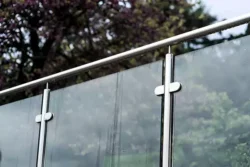

Few architectural elements combine transparency, safety and contemporary style as elegantly as a glass balustrade. Whether lining a staircase, edging a mezzanine or securing a rooftop terrace, these clear barriers invite light, preserve sight‑lines and underline modern minimalism. Yet context matters: indoor glass balustrades and outdoor balustrade design differ in load requirements, weather ability, fixings and upkeep.
This article compares the two settings head‑to‑head so interior designers, landscape planners, builders and style‑savvy homeowners can specify the right system one that meets design ambitions and the strict building regulations for glass balustrades.

A glass balustrade (or glass railing) is a safety barrier formed predominantly of glass panels with or without a supporting frame. Its primary purpose is to prevent falls from raised edges while maintaining openness and light flow.
Both settings increasingly favour frameless balustrade systems, where laminated safety glass slots into a slim aluminium or stainless‑steel channel, erasing vertical posts for an uninterrupted look.
Which Glass Is Right for Your Balustrade?
Not all glass is created equal when safety and clarity matter. Learn the differences between toughened and laminated options in our in-depth guide to the best glass types for balustrades.
| Design Driver | Indoor Glass Balustrades | Outdoor Glass Balustrade Design |
|---|---|---|
| Visual goals | Light bounce, reflection, slim sight‑lines | Unobstructed landscape views, wind protection, visual link to garden |
| Handrail choices | Timber, powder‑coated steel, or cap‑less (structural glass acts as rail) | Stainless steel or cap‑less; timber less common outdoors due to weathering |
| Glass height | 900 mm min. on stairs/mezzanines (UK regs) | 1,100 mm min. on balconies & roof edges |
| Wind loading | Negligible | Must resist lateral wind pressure; thicker laminates required |
| Privacy needs | Often clear or low‑iron; frosted for WC lobbies | Tinted, frosted or fritted patterns to screen neighbours without sacrificing light |
| Sound attenuation | Usually not critical | Laminated acoustic interlayers can cut traffic noise on balconies |
Design tip: Indoors, the balustrade can become a sculptural element consider low‑iron glass and warm oak handrails for a gallery vibe. Outdoors, treat the balustrade as part of the façade: coordinate glass tint and metal finishes with cladding colours for a cohesive envelope.

| Setting | Typical Build‑Up | Notes |
|---|---|---|
| Indoor | 6 mm toughened + 6 mm toughened with PVB interlayer (laminated) | Meets BS 6180 for domestic stairs; low‑iron option for crystal clarity |
| Outdoor | 10 mm toughened + 10 mm toughened with SentryGlas® or stiff PVB | Handles higher live loads and wind suction; UV‑stable interlayer resists yellowing |
Detailing insight: A cap‑less balustrade relies on the glass itself as the handrail. That demands laminated glass so if one pane shatters, the interlayer holds shards in place an absolute glass railing safety must.

Planning a Skylight? Choose the Right Material
Whether glass or polycarbonate, your choice affects light, insulation, and lifespan. Explore our breakdown of the best materials for skylights based on performance and aesthetics.
United Kingdom (similar principles apply across many regions)
Are Skylights Worth It in the UK Climate?
Rain, insulation, and natural light — find out how skylights perform in British weather and if they justify the investment in our article: Are skylights worth it in the UK?
Longevity pointer: A high‑performance interlayer such as SentryGlas® keeps edges clear and reduces “edge clouding” common in PVB laminates exposed to constant humidity.
Why Go Custom with Skylights?
Standard rooflights don’t always fit your architecture or goals. See how bespoke design enhances comfort and resale value in our guide to the best custom skylights.
Every location demands a different balance between appearance, strength, and maintenance. Below are the key advantages and drawbacks of each type of glass balustrade to help you decide which fits your project best.
Design Tip
Indoors, glass balustrades act as sculptural design features. Outdoors, they become part of the building’s protective envelope. Balancing both aesthetics and performance ensures lasting clarity, safety, and architectural harmony.
Choosing between indoor and outdoor glass balustrades isn’t just a question of style, it’s about how the space functions, what conditions it faces, and the kind of experience you want to create. Both options share the same design DNA of transparency and elegance, but their performance priorities differ in ways that directly affect cost, maintenance, and safety.
If your project is indoors (a staircase, mezzanine, or atrium) focus on visual flow and architectural refinement. Here, glass balustrades can become sculptural elements, connecting levels without blocking light or sightlines.
Frameless systems with low-iron or clear toughened glass are ideal for this setting, giving a floating, gallery-like effect that enhances interior brightness. Since they’re protected from wind and weather, thinner laminated panels (such as 6 + 6 mm) are usually sufficient, making installation simpler and maintenance almost effortless.
For outdoor applications durability and safety take priority. You’ll need thicker laminated glass, usually 10 + 10 mm or greater, to withstand lateral wind loads and external pressure. Choose marine-grade stainless steel (A4/316) fittings, especially near the coast or pool areas, to prevent corrosion.
While the upfront investment is higher, outdoor frameless balustrades deliver unmatched visual rewards: panoramic views, a cleaner façade, and an architectural finish that feels both modern and permanent.
If budget is a concern, framed or semi-frameless systems can offer a compromise, they reduce hardware costs while retaining much of the transparency of frameless designs. But if your goal is a truly seamless aesthetic and long-term performance, full frameless systems are worth every penny.
When making your final decision, think long-term:
Ultimately, the best choice is the one that aligns with both your design ambitions and the technical realities of your space. If you’re unsure which specification suits your project, consulting a specialist like SM Glasstech can help. Their engineers assess site conditions, wind zones, and design goals to recommend a fully compliant, visually stunning system, whether you’re elevating an interior staircase or opening up an outdoor view.
A glass balustrade should be invisible to the eye yet rock‑solid under load. Achieving that balance means tailoring the system to its environment:
Whichever setting you’re designing, remember the golden trio of glass railing safety: correct lamination, compliant height, and engineer‑verified fixings. Combine those with thoughtful maintenance and your frameless balustrade system will stay crystal‑clear and code‑ready for decades—an architectural flourish that protects as confidently as it impresses.
Need project‑specific advice? SM Glasstech engineers can model loads, detail channels, and supply fully tested balustrade kits delivered nationwide to contractors and homeowners alike.


Send us your contact details and a specialist will get in touch with you.